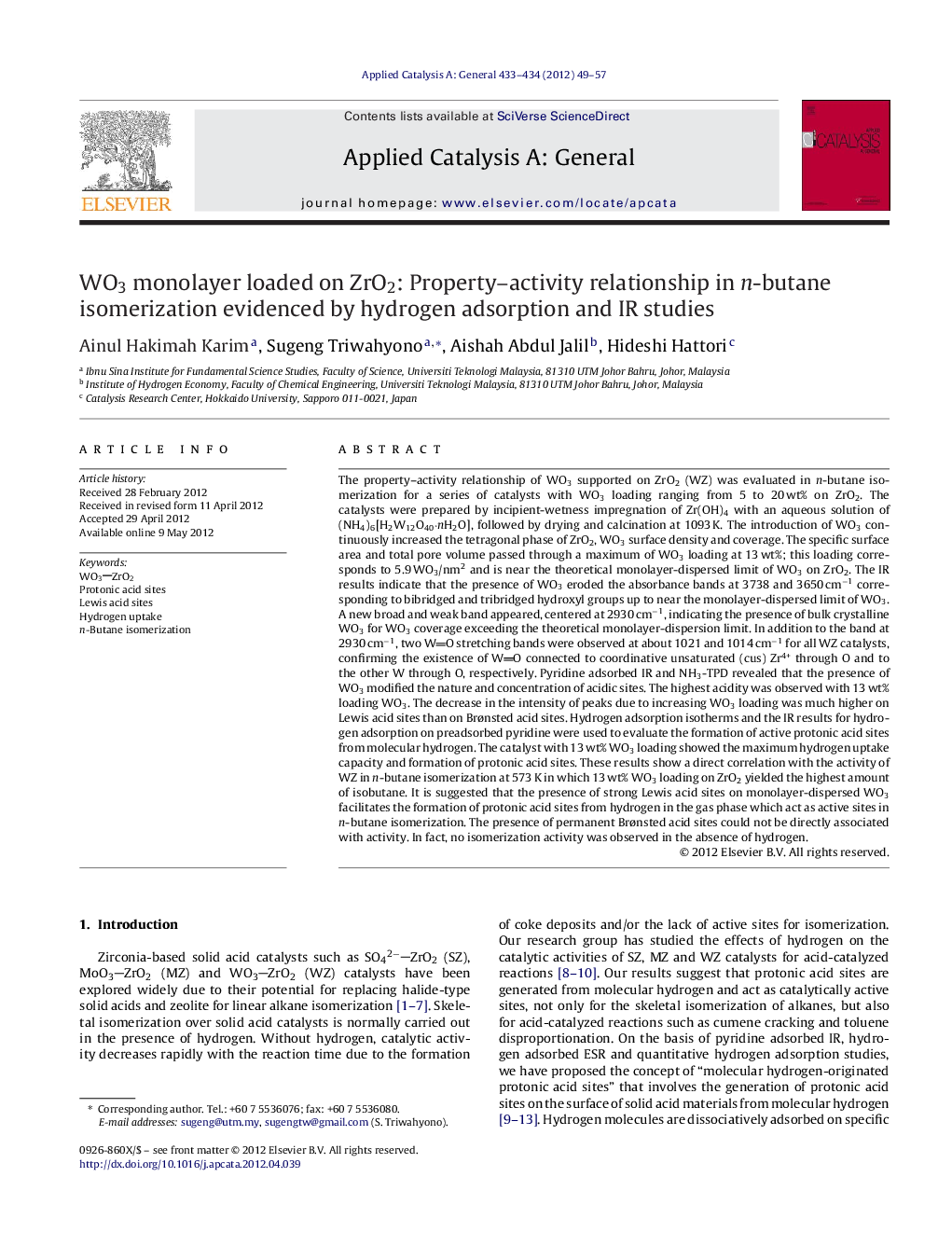| کد مقاله | کد نشریه | سال انتشار | مقاله انگلیسی | نسخه تمام متن |
|---|---|---|---|---|
| 40870 | 45869 | 2012 | 9 صفحه PDF | دانلود رایگان |

The property–activity relationship of WO3 supported on ZrO2 (WZ) was evaluated in n-butane isomerization for a series of catalysts with WO3 loading ranging from 5 to 20 wt% on ZrO2. The catalysts were prepared by incipient-wetness impregnation of Zr(OH)4 with an aqueous solution of (NH4)6[H2W12O40·nH2O], followed by drying and calcination at 1093 K. The introduction of WO3 continuously increased the tetragonal phase of ZrO2, WO3 surface density and coverage. The specific surface area and total pore volume passed through a maximum of WO3 loading at 13 wt%; this loading corresponds to 5.9 WO3/nm2 and is near the theoretical monolayer-dispersed limit of WO3 on ZrO2. The IR results indicate that the presence of WO3 eroded the absorbance bands at 3738 and 3650 cm−1 corresponding to bibridged and tribridged hydroxyl groups up to near the monolayer-dispersed limit of WO3. A new broad and weak band appeared, centered at 2930 cm−1, indicating the presence of bulk crystalline WO3 for WO3 coverage exceeding the theoretical monolayer-dispersion limit. In addition to the band at 2930 cm−1, two WO stretching bands were observed at about 1021 and 1014 cm−1 for all WZ catalysts, confirming the existence of WO connected to coordinative unsaturated (cus) Zr4+ through O and to the other W through O, respectively. Pyridine adsorbed IR and NH3-TPD revealed that the presence of WO3 modified the nature and concentration of acidic sites. The highest acidity was observed with 13 wt% loading WO3. The decrease in the intensity of peaks due to increasing WO3 loading was much higher on Lewis acid sites than on Brønsted acid sites. Hydrogen adsorption isotherms and the IR results for hydrogen adsorption on preadsorbed pyridine were used to evaluate the formation of active protonic acid sites from molecular hydrogen. The catalyst with 13 wt% WO3 loading showed the maximum hydrogen uptake capacity and formation of protonic acid sites. These results show a direct correlation with the activity of WZ in n-butane isomerization at 573 K in which 13 wt% WO3 loading on ZrO2 yielded the highest amount of isobutane. It is suggested that the presence of strong Lewis acid sites on monolayer-dispersed WO3 facilitates the formation of protonic acid sites from hydrogen in the gas phase which act as active sites in n-butane isomerization. The presence of permanent Brønsted acid sites could not be directly associated with activity. In fact, no isomerization activity was observed in the absence of hydrogen.
Figure optionsDownload high-quality image (102 K)Download as PowerPoint slideHighlights
► The addition of WO3 modified the nature and concentration of the acidic sites.
► 13 wt% WO3ZrO2 (13WZ) led to the strongest Lewis and Brønsted acid sites.
► 13WZ exhibited the greatest ability and capacity to form and to take up H+.
► The H2 uptake capacity was shown to be directly correlated with the activity of WZ.
► Permanent H+ could not be directly associated with the activity of WZ.
Journal: Applied Catalysis A: General - Volumes 433–434, 8 August 2012, Pages 49–57